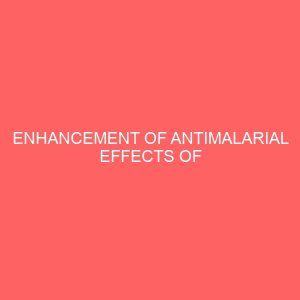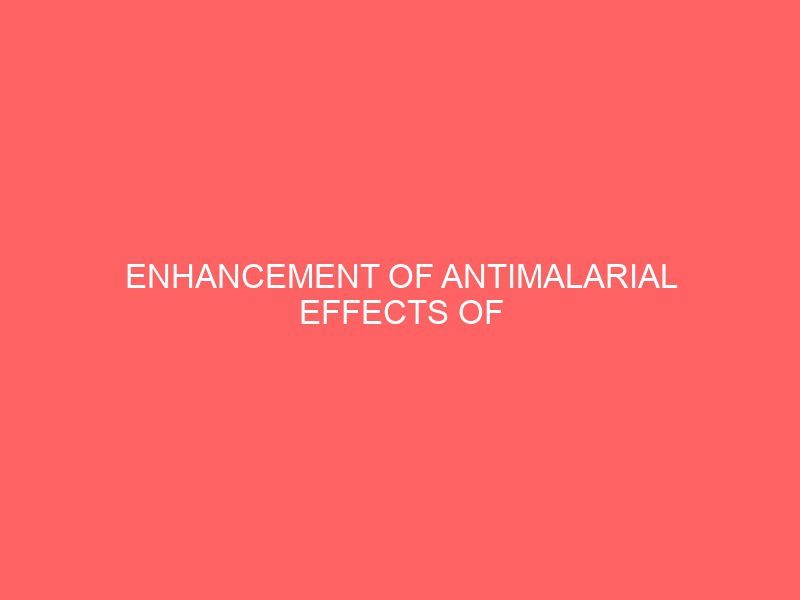Description
ABSTRACT
The emergence and spread of Plasmodium spp with resistance to chloroquine CQ, the cheapest antimalarial drug coupled with the high cost of artermisinin combination therapies has necessitated the need to combine chloroquine with drugs that improve its effectiveness The present study determines the ability of chlorpheniramine CP to enhance the therapeutic efficacy of chloroquine against Plasmodium berghei malaria in mice P berghei was used to develop respective experimental rodent malaria models based on intraperitoneal injection of 106 parasitize erythrocyte suspension in PBS pH, 72 and subsequent development of parasitaemia Effect of 0057 and 0029 mg/kg of CP on the therapeutic efficacy of CQ at 14 mg/kg for 2 days and 7 mg/kg on day 3 was evaluated using these experimental models The level of parasitaemia in the different groups was monitored throughout the period of the study using microscopic method Haematological parameters: RBC, Hb, PCV and WBC were determined using standard methods The acute toxicity of the CQchlorpheniramine combinations was determined enzymatically by the methods of Reitman and Frankel Also, histopathology study of the liver was carried out to determine the histopathological changes in the liver using Bancroft and Steven method The results from this study demonstrate that at day 3, CQ in combination with normal dose CP had significantly higher reduction 939 in percentage parasitaemia compared to CQ alone 561 It was also noted that CP demonstrated antiplasmodial activity in Pberghei infected mice at Day 1, 2 and 3 with percentage reduction of 192, 402 and 694 respectively The untreated group of mice infected with P berghei recorded 582 , 555 and 523 reduction in RBC, PCV and Hb respectively compared with the uninfected group The result of the liver enzyme assay shows that CQ and CP combination showed ameliorative effect of the liver damages caused by malaria parasitaemia However, CP indeed enhanced the therapeautic efficacy of CQ with minimal deleterious effect in Pberghei infected mice Chlorpheniramine is a safe therapeutic drug; therefore, the clinical use of chlorpheniramine as a cheap and highly effective combination with chloroquine holds great promise against malaria treatment
TABLE OF CONTENTS
Title Page i
Certification Page ii
Dedication iii
Acknowledgement iv
Table of Contents v
List of Abbreviations x
List of Figures xii
Abstract xiii
CHAPTER ONE: INTRODUCTION
11 Background of the Study 1
12 Malaria 2
121 Definition of Malaria 2
122 Incidence/Prevalence of Malaria 2
123 Epidemiology 4
124 Life Cycle of Plasmodium Parasite 5
125 The Clinical Manifestation of Malaria 9
1251 Prognosis of Malaria 11
126 Diagnosis of Malaria 11
1261 Clinical Diagnosis 12
1262 Parasitology Diagnosis 13
1263 Molecular Diagnosis 15
127 Establishing of Malaria Parasite Counts 15
1271 Method One: Parasites Per Micro Litre of Blood 15
1272 Method Two: The Plus System 16
128 The Past and Present Anti Malaria Drug Discovery 17
129 Resistance 19
1210 Impact of Resistance 20
1211 Factors Contributing to the Spread of Resistance 21
12111 Biological Influence on Resistance 21
12112 The Programmatic Influence on Resistance 26
1212 Detection of Resistance 27
12121 In Vivo Test 28
12122 In Vitro Test 30
12123 Animal Model Studies 31
12124 Molecular Techniques 31
12125 Case Report and Passive Detection of Treatment Failure 32
13 Chloroquine 33
131 Definition 33
132 Absorption, Metabolism and Execration of CHQ 34
133 Mechanism of Action 37
134 Mechanism of Chloroquine Resistance 38
14 Chlorphenramine 39
141 Definition 39
142 Combination Medications 40
143 Synthesis 41
15 White Blood Cells 42
151 Granulocytes 42
1511 Neutrophils 43
1512 Eosinophils 43
1513 Basophils 43
152 Agranulocytes 44
1521 Lymphocytes 44
1522 Monocytes 44
153 White Blood Cell Production 45
17 Red Blood Cell 45
171Morphology of Human Erytrocytes 46
172 Life Cycle 47
173 Packed Cell Volume PCV 48
1731 Measurement Method 48
18 Haemoglobin 49
181 Genetics 50
182 Synthesis 52
19 The Aminotransferases 52
191 Aspartate Aminotransferase 53
1911 Function 53
1912 Mechanism 54
1913 Clinical Significance 55
192 Alanine Transaminase 56
1921 Function 56
1922 Clinical Significance 56
110 Liver 56
1101 Anatomy of the Liver 57
1102 Histology 58
111 Statement of Problem 58
112 Purpose of the Study 58
113 Significance of the Study 59
CHAPTER TWO: MATERIALS AND METHODS
21 Materials 60
211 Drugs 60
212 Animals 60
213 Parasites 60
214 Equipments and Reagents 61
22 Methods 62
221 Parasite Density Determination and Inoculums Preparation 62
222 Parasitaemia Determination 62
223 Curative Treatment 62
224 Haematological Parameters 64
2241 Determination of Packed Cell Volume 64
2242 Haemoglobin 64
2243 Determination of Total Leukocyte White Blood Cell Count 64
2244 Determinaton of Total Erythrocyte Red Blood Cell Count 65
225 Biochemical Parameters 65
2251 Determination of Aspartate Aminotransferase AST Activity 65
2252 Determination of Alanine Aminotransferase ALT Activity 66
226 Histopathology 66
227 Statistical Analysis 67
CHAPTER THREE: RESULTS AND DISCUSSION
32 Results 68
321 Results of Antiplasmodial Testing 68
312 Haematology 72
313 Biochemistry 81
314 Histopathology 85
CHAPTER FOUR: SUMMARY, CONCLUSION AND RECOMMENDATION
41 Summary 89
42 Conclusion 90
43 Recommendations 90
References 92
Appendix 103








Reviews
There are no reviews yet.